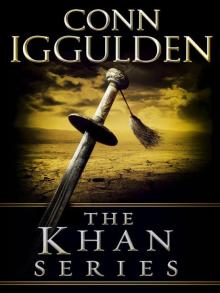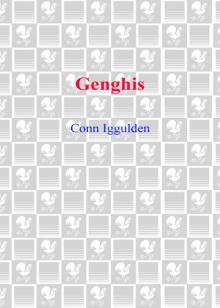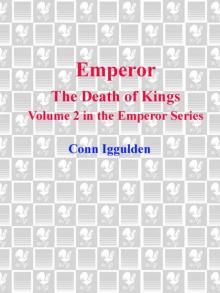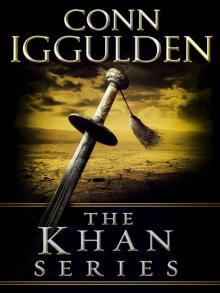- Home
- Conn Iggulden
The Dangerous Book for Boys Page 2
The Dangerous Book for Boys Read online
Page 2
6.The Colossus of Rhodes in Greece is perhaps the most famous of the seven ancient wonders. It was a statue of Helios, over a hundred feet (30 m) high.
It did not actually stand across the harbor, but instead rested on a promontory, looking out over the Aegean Sea. The base was white marble and the statue was built slowly upward, strengthened with iron and stone as the bronze pieces were added. It took twelve years and was finished around 280 BC, quickly becoming famous. An earthquake proved disastrous for the statue fifty years later. It broke at the knee and crashed to the earth to lie there for eight hundred years before invading Arabs sold it.
7.The Pharos Lighthouse at Alexandria was built by the architect Sostratus of Cnidus for the Greco-Egyptian king Ptolemy Philadelphus (285–247 BC).
Ptolemy’s ancestor had been one of Alexander the Great’s generals. His most famous descendant is Cleopatra, who was the first of her Greek line actually to speak Egyptian.
When Julius Caesar arrived in Alexandria, he would have passed by the great light-house on Pharos island. Its light was said to be visible for 35 miles (55 km) out to sea. Its exact height is unknown, but to have shed visible light to that distance, it must have been between 400 and 600 feet high (121–182 m).
It was so famous that, even today, the word for lighthouse in Spanish and Italian is “faro.” French also uses the same root, with “phare.”
As you can see, even the greatest wonders can be lost or broken by the passage of millennia. Perhaps the true wonder is the fact that we build them, reaching always for something greater than ourselves.
The Five Knots Every Boy Should Know
BEING ABLE TO TIE KNOTS in rope is extremely useful. It is amazing how many people only know a reef and a granny knot. Rather than naming hundreds, we’ve narrowed it down to five extremely useful examples.
However, they take endless practice. I learned a bowline on a sailing ship in the Pacific. For three weeks, I used an old bit of rope on every watch, night and day. On my return to England, I attempted to demonstrate the knot—and found it had vanished from memory. To be fair, it didn’t take long to recall, but knots should be practiced every now and then so they will be there when you need them. There are hundreds of good books available, including expert levels of splicing and decorative knots. These are the standard basics—useful to all.
1. THE REEF KNOT
This knot is used to reef sails—that is, to reduce the amount of sail area when the wind is getting stronger. If you look at a dinghy sail, you’ll notice cords hanging from the material. As the sail is folded on the boom, the cords are tied together using reef knots. It is symmetrical and pleasing to the eye.
The rule to remember is: left over right, right over left.
2. THE FIGURE EIGHT
This is a “stopper”—it goes at the end of a rope and prevents the rope passing through a hole. A double figure eight is sometimes used to give the rope end weight for throwing. It’s called a figure eight because it looks like the number eight.
3. THE BOWLINE (PRONOUNCED BOW-LIN)
This is a fantastically useful, solid knot. It is used whenever a loop on the end of a rope is needed—for a post, a ring, or anything else really.
Make a loop toward yourself, leaving enough free at the end to go around your post, tree, or similar object.
Now—imagine the loop is a rabbit hole and the tip is the rabbit. The other end of the rope is the tree. Feed the tip up through the hole—the rabbit coming up.
Pass the rabbit round the back of the tree.
Pass the rabbit back down the hole—back into the original loop.
Pull tight carefully.
NOTE: You can make a simple lasso by making a bowline and passing the other end of the rope through the loop. The bowline does not slip, so it is useful for making a loop to lower someone, or to throw to a drowning person.
4. SHEET BEND
This is a useful knot for joining two ropes together. Reef knots fail completely when joining ropes of different diameters—but a sheet bend works very well.
A Sheet Bend
5. A CLOVE HITCH—FOR HITCHING TWO THINGS TOGETHER VERY QUICKLY
This is a short-term knot—the sort of thing you see used by cowboys in westerns to hitch their horses. Its main benefit is that it’s very fast to make. Basically, it’s wrapping a rope around a post and tucking an end into a loop. Practice this one over and over until you can do it quickly.
These five knots will be useful in a huge variety of situations, from building a treehouse to camping, to sailing, to tying up your horse outside a saloon. They will not come easily. They take practice and patience. Knowing this will not impress girls, but it could save your life—or your horse.
Questions About the World—Part One
1. Why is a summer day longer than a winter day?
2. Why is it hotter at the Equator?
3. What is a vacuum?
4. What is latitude and longitude?
5. How do you tell the age of a tree?
1. WHY IS A SUMMER DAY LONGER THAN A WINTER DAY?
In Australia, the shortest day is June 21, and the longest falls on December 21. In the northern hemisphere, June 21 is midsummer and midwinter falls on December 21. Christmas in Australia is a time for barbecues on the beach.
Although the North Pole points approximately at the star Polaris, the earth’s axis is tilted twenty-three and a half degrees in respect to the path it takes around our sun.
While the northern hemisphere leans toward the sun, more direct sunlight reaches us. We call this period summer. June 21 is the day when the North Pole points directly toward the sun, and the tilt is at maximum. The days are longest then as most of the northern hemisphere is exposed. Down in the south, the days are shortest as the earth itself blocks light from reaching the shivering inhabitants.
As the earth moves around the sun, the tilt remains the same. The autumnal equinox (September 22 or 23) is the day when day and night are of equal length—twelve hours each, just as they are on the vernal equinox in spring on March 20. “Equinox” comes from the Latin for “equal” and “night.”
When the northern hemisphere leans away from the sun, less light reaches the surface. This is autumn for us, and eventually winter. Longer days come to the southern hemisphere as shorter days come to the north. The summer solstice of June 21 is also the moment when the sun is highest in the sky.
The earth is actually closer to the sun in January rather than June. It’s not the distance—it’s the tilt.
The best way to demonstrate this is by holding one hand up as a fist and the other as a flat palm representing the Earth’s tilt. As your palm moves around the fist, you should see how the tilt creates the seasons and why they are reversed in the southern hemisphere. Be thankful that we have them. One long summer or one long winter would not support life.
At the midsummer and midwinter solstices, the conditions can become very peculiar indeed. The summer sun will not set for six months at the North and South Poles, but when it does set, it does not rise for another six. Northern countries such as Finland also experience the “midnight sun” effect.
2. WHY IS IT HOTTER AT THE EQUATOR?
There are two reasons why the Equator is hotter than the rest of the planet. Strangely enough, the fact that it is physically closer to the sun than, say, the North Pole is not relevant. The main reason is that the earth curves less in the equatorial region. The same amount of sunlight is spread over a smaller area. This can be clearly seen in the diagram below.
Also, the sun’s rays have to pass through less atmosphere to reach the equatorial band—and so retain more of their heat.
3. WHAT IS A VACUUM?
A perfect vacuum is a space with absolutely nothing in it—no air, no matter of any kind. Like the temperature of absolute zero (–273.15 °C/0 Kelvin), it exists only in theory. The light bulbs in your home have a “partial vacuum,” with most of the air taken out as part of the manufacturing process. Without t
hat partial vacuum, the filament would burn far faster, as air contains oxygen.
The classic science experiment to show one quality of a vacuum is to put a ticking clock inside a bell jar and expel the air with a pump. Quite quickly, the sound becomes inaudible: without air molecules to carry sound vibrations, there can be no sound. That is why in space, no one can hear you scream!
4. WHAT IS LATITUDE AND LONGITUDE?
The earth is a globe. The system of latitude and longitude is a man-made system for identifying a location anywhere on the surface.
Latitude takes the Equator as a line of zero. If you cut the world in half at that point, you would have a horizontal plate. The center point of that plate is at ninety degrees to the Poles above and below it.
Latitude is not measured in miles but in the degrees between ninety and zero in both hemispheres. London, for example is at 51 latitude north. The curve representing the ninety-degree change is split into imaginary lines called “parallels”—because they are all parallel to one other and the Equator.
With something as large as the earth, even a single degree can be unwieldy. For both longitude and latitude, each degree is split into sixty “minutes of arc.” Each minute of arc is split into a further sixty “seconds of arc.” The symbols for these are:
Degrees: °Minutes: 'Seconds: "
With something as large as a city, the first two numbers would suffice. London would be 51 32 N, for example. The location of a particular house would need that third number, as well as a longitude coordinate.
There is an element of luck in the fact that a latitude degree turned out to be almost exactly sixty nautical miles—making a minute of latitude conveniently close to one nautical mile, which is 6,000 feet (1852 meters).
The longitude of London is zero, which brings us neatly into longitude.
Longitude is a series of 360 imaginary lines stretching from Pole to Pole. London is zero and 180 degrees stretch to the west or east.
If the world turns a full circle in a day, that is 360 degrees. 360 divided by 24 = 15 degrees turn every hour. We call the fifteen-degree lines “meridians.” (“Meridian” means “noon,” so there are twenty-four noon points around the planet.)
Now, this is how it worked. On board your ship in the middle of nowhere, you took a noon sighting—that is, took note of the time as the sun passed its highest point in the sky. You could use a sextant and a knowledge of trigonometry to check the angle. If you were at noon and your ship’s clock told you Greenwich, England, was at nine in the morning, you would have traveled three meridian lines east or west—which one depending on your compass and watching the sun rise and set. You would be at longitude +/– 45°, in fact.
Having a clock that could keep the accurate time of Greenwich even while being tossed and turned on a ship was obviously crucial for this calculation. John Harrison, a clock maker from Yorkshire, England, created a timepiece called H4 in 1759 that was finally reliable enough to be used.
All that was left was to choose the Prime Meridian, or zero-degree point of longitude. For some time it looked as if Paris might be a possibility, but trade ships in London took their time from the Greenwich clock at Flamstead House, where a time ball would drop to mark 1 p.m. each day. Ship chronometers were set by it and Greenwich time became the standard. In 1884 a Washington conference of twenty-five nations formalized the arrangement. If you go to Greenwich today, you can stand on a brass line that separates the west from the east.
On the opposite side of the world, the two hemispheres meet at the International Date Line in the Pacific Ocean. It’s called the International Date Line because we’ve all agreed to change the date when we cross it. Otherwise, you could travel west from Greenwich, back to 11 a.m., 10 a.m., 9 a.m., all the way around the planet until you arrived the day before. Obviously this is not possible, and so crossing the line going west would add a day to the date. Complex? Well, yes, a little, but this is the world and the systems we made to control it.
Like latitude, longitude is broken down into a three-figure location of degrees, minutes and seconds. Common practice puts the latitude figures first, but it’s always given away by the North or South letter so they can’t really be confused. A full six-figure location will look something like these:
38° 53' 23" N, 77° 00' 27" W Washington, D.C.
39° 17' 00" N, 22° 23' 00" E Pharsalus, Greece, where Julius Caesar beat Pompey and ended the civil war
39° 57' 00" N, 26° 15' 00" E Troy
6. HOW DO YOU TELL THE AGE OF A TREE?
You cut it down and count the rings. For each year of growth, a dark and a light ring of new wood is created. The two bands together are known as the “annual ring.” The lighter part is formed in spring and early summer when the wood cells are bigger and have thinner walls which look lighter. In autumn and winter, trees produce smaller cells with thicker walls, which look darker. They vary in width depending on growing conditions, so a tree stump can be a climate record for the life of the tree—sometimes even centuries. The age of a tree, therefore, can be told by counting the annual rings.
Making a Battery
A BATTERY AT ITS SIMPLEST is a cathode (the positive end), an anode (the negative end), and electrolyte (the bit in the middle). There are quite a few different combinations out there. Electricity is the movement of electrons, tiny negatively charged particles. The anode tends to be made of a substance that gives up electrons easily—like zinc, which gives up two electrons per zinc atom. The cathode tends to be made of substances that accept electrons easily, like copper.
The electrolyte inside can be a liquid, a gel, or a paste. All that matters is that it contains positive and negatively charged ions that flow when the anode and cathode are activated. When the Italian physicist Alessandro Volta made the first battery, he used copper for the cathode, zinc for the anode and an electrolyte of blotting paper and seawater. His name gives us the word “volt,” as in a 12-volt car battery. If you think of electricity as a water pipe, a volt will be the speed of the water, but it also needs a big hole to flow through—or “amps.” You can have enough voltage to make your hair stand on end, but without amps, it won’t do more than cause a tiny spark. A house supply, however, has 240 volts and enough amps to kill you as dead as a doornail.
* * *
You will need
Ten quarters.
Metal kitchen foil.
Blotting paper.
Two pieces of copper wire (taken from any electrical wire or flex).
Cider vinegar.
Salt.
Bowl.
LED—a light emitting diode (available from model and hardware shops).
Masking tape.
* * *
The copper coin will be the cathode, the foil the anode.
Cut the foil and blotting paper into circles so they can be stacked on top of each other. The blotting paper will be soaked in the vinegar, but it is also there to prevent the metals touching—so cut those paper circles a little larger than the foil or coins.
1.Mix vinegar and a little salt together in the bowl. Vinegar is acetic acid and all acids can be used as an electrolyte. Sulfuric acid is found in car batteries, but don’t fool around with something that powerful. It eats clothing and can burn skin—unlike vinegar, which goes on your salad.
Common salt is sodium chloride, a combination of a positive and negative ion (Na+ and Cl–). These will separate in the electrolyte, increasing its strength.
2.Soak your circles of blotting paper in the ion-rich electrolyte.
3.With the masking tape, attach the end of one wire to the underneath of a foil disk. This is the negative terminal. Now stack in this sequence—foil, paper, coin, foil, paper, coin. Each combination is its own tiny battery—but to light even an LED (light-emitting diode) you’ll need quite a few. A car battery tends to have six of these, but with a much larger surface area for each “cell.” As a general rule, the bigger a battery is, the more power it has. (Power measured in watts = amps × v
olts.)
All the positive ions will go to one terminal, all the negative ions to the other. In effect, you are charging your battery.
4.When you have a stack, you can attach a wire to the last coin with tape. This will be the positive terminal. They can now light an LED, as in the picture below, or with enough coin batteries, even a small bulb.
There may come a time when batteries go on to a new generation, but if you can understand the battery you have just made, you can understand every type of battery currently available, from nickel-cadmium to lithium-ion, from rechargeable phone batteries, to the ones that drive toy rabbits. You won’t hear acid sloshing in alkaline batteries, where a paste or gel is used, but the principles are identical.
How to Play Stickball
IF YOU’VE GOT a few spare hours on a Sunday afternoon—even if gloves and bats are readily available—you might still consider a game of stickball. It is a lot like baseball, but without the formal equipment or field. The game was most popular in the 1930s in New York and other cities, but it is still alive and well in empty lots and the slow traffic streets of Brooklyn.
Baseball legend Willie Mays, who had 3,283 hits and 660 home runs over his career, said that he learned to hit the breaking-ball pitch by playing stickball because the ball takes unpredictable bounces.

 The Khan Series 5-Book Bundle
The Khan Series 5-Book Bundle Tollins 2: Dynamite Tales
Tollins 2: Dynamite Tales Tollins: Explosive Tales for Children
Tollins: Explosive Tales for Children The Field of Swords
The Field of Swords The Death of Kings
The Death of Kings Quantum of Tweed: The Man With the Nissan Micra
Quantum of Tweed: The Man With the Nissan Micra Bones of the Hills
Bones of the Hills Genghis: Birth of an Empire
Genghis: Birth of an Empire The Gates of Rome
The Gates of Rome Dunstan
Dunstan Fig Tree
Fig Tree The Gates of Athens
The Gates of Athens Stormbird
Stormbird Khan: Empire of Silver
Khan: Empire of Silver The Abbot's Tale
The Abbot's Tale Gengis: Lords of the Bow
Gengis: Lords of the Bow The Gods of War
The Gods of War Blackwater
Blackwater Ravenspur: Rise of the Tudors
Ravenspur: Rise of the Tudors Wars of the Roses: Trinity (War of the Roses Book 2)
Wars of the Roses: Trinity (War of the Roses Book 2) The Gods of war e-4
The Gods of war e-4 The Dangerous Book of Heroes
The Dangerous Book of Heroes Stormbird wotr-1
Stormbird wotr-1 Emperor: The Death of Kings
Emperor: The Death of Kings Conqueror (2011) c-5
Conqueror (2011) c-5 The Dangerous Book for Boys
The Dangerous Book for Boys Genghis Lords of the Bow
Genghis Lords of the Bow Emperor: The Blood of Gods (Special Edition) (Emperor Series, Book 5)
Emperor: The Blood of Gods (Special Edition) (Emperor Series, Book 5) The Emperor Series: Books 1-5
The Emperor Series: Books 1-5 Lords of the Bow c-2
Lords of the Bow c-2 Lords of the Bow
Lords of the Bow Quantum of Tweed
Quantum of Tweed Wars of the Roses 01 - Stormbird
Wars of the Roses 01 - Stormbird Empire of Silver c-4
Empire of Silver c-4 Birth of an Empire
Birth of an Empire Conqueror (2011)
Conqueror (2011) Wars of the Roses: Bloodline: Book 3 (The Wars of the Roses)
Wars of the Roses: Bloodline: Book 3 (The Wars of the Roses) Bones Of the Hills c-3
Bones Of the Hills c-3 Empire of Silver
Empire of Silver The Khan Series 5-Book Bundle: Genghis: Birth of an Empire, Genghis: Bones of the Hills, Genghis: Lords of the Bow, Khan: Empire of Silver, Conqueror
The Khan Series 5-Book Bundle: Genghis: Birth of an Empire, Genghis: Bones of the Hills, Genghis: Lords of the Bow, Khan: Empire of Silver, Conqueror The Falcon of Sparta
The Falcon of Sparta Explosive Tales for Children
Explosive Tales for Children